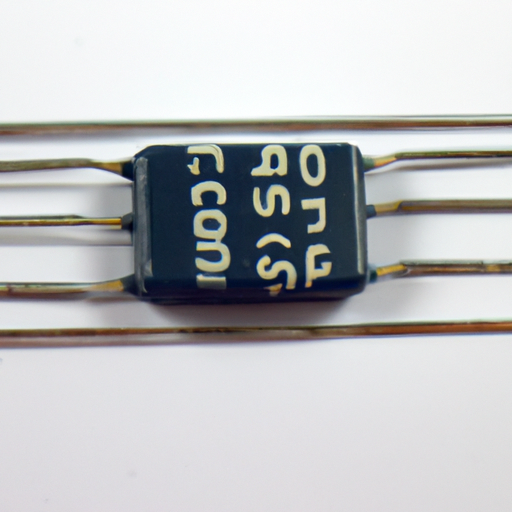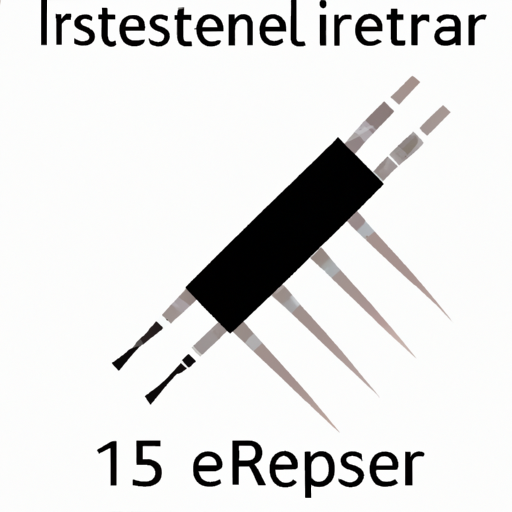
What is the Function of the New Resistor and When Will It Be Released? I. IntroductionIn the world of electronics, resistors play a crucial role in the functionality and efficiency of circuits. A resistor is a passive electrical component that limits the flow of electric current in a circuit, allowing for the control of voltage and current levels. This simple yet essential component is found in virtually every electronic device, from smartphones to industrial machinery. As technology advances, so too does the need for more efficient and reliable components. This brings us to the new resistor, which promises to enhance performance in various applications. In this blog post, we will explore the function of this new resistor, its features, applications, and the anticipated release timeline. II. Understanding Resistors A. Basic Principles of ResistanceAt the heart of understanding resistors is Ohm's Law, which states that the current (I) flowing through a conductor between two points is directly proportional to the voltage (V) across the two points and inversely proportional to the resistance (R). This relationship is expressed mathematically as:\[ V = I \times R \]Resistors come in various types, including fixed, variable, and specialty resistors. Fixed resistors have a constant resistance value, while variable resistors, such as potentiometers, allow for adjustable resistance. Specialty resistors are designed for specific applications, such as thermistors for temperature sensing. B. Role of Resistors in Electronic DevicesResistors serve several critical functions in electronic devices:1. **Current Limiting**: By restricting the flow of current, resistors protect sensitive components from damage due to excessive current. 2. **Voltage Division**: Resistors can be used in voltage divider circuits to produce a specific output voltage that is a fraction of the input voltage.3. **Signal Conditioning**: In analog circuits, resistors help shape and filter signals, ensuring that they meet the required specifications for further processing. III. The New Resistor: Features and Innovations A. Description of the New ResistorThe new resistor is designed with advanced materials and technology to meet the demands of modern electronic applications. Key specifications include:Material: Constructed from high-quality, temperature-stable materials that enhance performance.Size: Compact design that allows for integration into smaller devices without compromising functionality.Resistance Range: Available in a wide range of resistance values to cater to various applications. B. Technological AdvancementsThe new resistor incorporates several technological advancements that set it apart from traditional models:1. **Improved Performance Metrics**: Enhanced accuracy and stability across a broader temperature range, making it suitable for high-performance applications.2. **Enhanced Durability and Reliability**: Designed to withstand harsh environmental conditions, ensuring longevity and consistent performance. C. Comparison with Existing ResistorsWhen compared to existing resistors, the new model offers several advantages:1. **Advantages Over Traditional Models**: The new resistor's improved thermal stability and power rating make it ideal for high-frequency and high-power applications.2. **Potential Drawbacks or Limitations**: While the new resistor boasts many benefits, it may come at a higher cost than standard resistors, which could be a consideration for budget-sensitive projects. IV. Applications of the New Resistor A. Target IndustriesThe new resistor is poised to make a significant impact across various industries, including:1. **Consumer Electronics**: With the growing demand for compact and efficient devices, the new resistor can enhance performance in smartphones, tablets, and wearables.2. **Automotive**: As vehicles become more reliant on electronic systems, the new resistor can improve the reliability of critical components in automotive applications.3. **Industrial Automation**: In industrial settings, the new resistor can optimize performance in control systems and machinery, contributing to increased efficiency and reduced downtime. B. Specific Use CasesThe versatility of the new resistor allows for a wide range of specific applications:1. **High-Frequency Applications**: Ideal for RF circuits and communication devices, where signal integrity is paramount.2. **Power Management Systems**: The new resistor can enhance the efficiency of power supplies and converters, contributing to energy savings.3. **IoT Devices**: As the Internet of Things continues to expand, the new resistor can support the development of smart devices that require reliable and efficient performance. V. Release Timeline and Market Impact A. Expected Release DateThe new resistor is currently in the final stages of development, with an expected release date set for the second quarter of 2024. The development process has involved rigorous testing and validation to ensure that the product meets industry standards.1. **Development Stages**: The resistor has undergone several phases, including prototype testing and feedback from industry experts.2. **Production and Distribution Plans**: Once released, the new resistor will be available through various distribution channels, ensuring accessibility for manufacturers and engineers. B. Market Demand and Potential ImpactThe anticipated release of the new resistor has generated significant interest within the engineering community. 1. **Anticipated Reception by Engineers and Manufacturers**: Early feedback suggests that engineers are excited about the potential applications and performance improvements offered by the new resistor.2. **Influence on Pricing and Competition**: The introduction of this innovative resistor may lead to increased competition in the market, potentially driving down prices for traditional resistors as manufacturers strive to keep pace with technological advancements. VI. ConclusionIn summary, the new resistor represents a significant advancement in resistor technology, offering improved performance, durability, and versatility for a wide range of applications. As we look to the future, the importance of innovation in electronic components cannot be overstated. The new resistor is not just a component; it is a stepping stone toward more efficient and reliable electronic systems. As we await its release, the excitement surrounding this innovation highlights the ongoing evolution of technology and the critical role that resistors will continue to play in shaping the future of electronics. VII. References1. "Understanding Resistors: A Comprehensive Guide." Electronics Tutorials. 2. "The Role of Resistors in Electronic Circuits." IEEE Spectrum.3. "Advancements in Resistor Technology." Journal of Electronic Materials.4. "Market Trends in Electronic Components." Electronics Weekly. This blog post provides a comprehensive overview of the new resistor, its features, applications, and the anticipated release timeline, emphasizing its significance in the ever-evolving landscape of electronics.

What are the Mainstream Models of Resistors Supplied? I. Introduction A. Definition of ResistorsResistors are passive electronic components that limit the flow of electric current in a circuit. They are fundamental to the operation of electronic devices, providing a means to control voltage and current levels. By converting electrical energy into heat, resistors play a crucial role in protecting sensitive components and ensuring the proper functioning of electronic systems. B. Importance of Resistors in Electronic CircuitsIn electronic circuits, resistors are essential for various functions, including voltage division, current limiting, and signal conditioning. They help maintain the desired operating conditions for other components, such as transistors and integrated circuits. Without resistors, circuits would be prone to damage from excessive current or voltage, leading to malfunction or failure. C. Overview of the ArticleThis article will explore the mainstream models of resistors supplied in the market today. We will discuss the different types of resistors, their key specifications, applications, selection criteria, and the latest trends in resistor technology. By the end of this article, readers will have a comprehensive understanding of resistors and their significance in electronic design. II. Types of ResistorsResistors can be broadly categorized into three main types: fixed resistors, variable resistors, and specialty resistors. A. Fixed ResistorsFixed resistors have a constant resistance value and are the most commonly used type in electronic circuits. They come in various materials and constructions, each with unique characteristics.1. **Carbon Composition Resistors**: Made from a mixture of carbon and a binding material, these resistors are known for their high energy absorption and ability to withstand high temperatures. However, they have a relatively high tolerance and are less stable over time.2. **Carbon Film Resistors**: These resistors are made by depositing a thin layer of carbon on a ceramic substrate. They offer better stability and lower noise compared to carbon composition resistors, making them suitable for precision applications.3. **Metal Film Resistors**: Constructed from a thin film of metal, these resistors provide excellent accuracy and stability. They have low temperature coefficients and are often used in high-precision applications.4. **Wirewound Resistors**: Made by winding a metal wire around a ceramic or fiberglass core, wirewound resistors can handle high power levels and are often used in power applications. They are available in both fixed and variable configurations.5. **Thick Film Resistors**: These resistors are made by printing a thick layer of resistive material onto a substrate. They are commonly used in surface mount technology (SMT) due to their compact size and cost-effectiveness.6. **Thin Film Resistors**: Similar to thick film resistors but with a thinner layer of resistive material, thin film resistors offer higher precision and stability, making them ideal for high-frequency applications. B. Variable ResistorsVariable resistors allow for adjustable resistance values, making them versatile components in electronic circuits.1. **Potentiometers**: These are three-terminal devices that can be used to adjust voltage levels in a circuit. They are commonly found in volume controls, tone controls, and other applications where variable resistance is needed.2. **Rheostats**: A type of variable resistor, rheostats are used to control current flow in a circuit. They typically have two terminals and are often used in applications requiring high power, such as lighting control. C. Specialty ResistorsSpecialty resistors are designed for specific applications and offer unique functionalities.1. **Thermistors**: These temperature-sensitive resistors change resistance with temperature variations. They are widely used in temperature sensing and control applications.2. **Photoresistors (LDRs)**: Light-dependent resistors change resistance based on light intensity. They are commonly used in light-sensing applications, such as automatic lighting systems.3. **Varistors**: Voltage-dependent resistors are used to protect circuits from voltage spikes. They exhibit a nonlinear resistance characteristic, making them effective in surge protection applications. III. Key Specifications of ResistorsWhen selecting resistors, several key specifications must be considered to ensure optimal performance in a given application. A. Resistance ValueThe resistance value, measured in ohms (Ω), determines how much current will flow through the resistor when a voltage is applied. It is crucial to select the correct resistance value to achieve the desired circuit behavior. B. ToleranceTolerance indicates the allowable deviation from the specified resistance value. It is expressed as a percentage and is essential for applications requiring precision. Common tolerance values include ±1%, ±5%, and ±10%. C. Power RatingThe power rating, measured in watts (W), indicates the maximum power the resistor can dissipate without overheating. Exceeding this rating can lead to resistor failure, so it is vital to choose a resistor with an appropriate power rating for the application. D. Temperature CoefficientThe temperature coefficient measures how much the resistance value changes with temperature variations. It is expressed in parts per million per degree Celsius (ppm/°C). A low temperature coefficient is desirable for applications requiring stability over a wide temperature range. E. Voltage RatingThe voltage rating indicates the maximum voltage that can be applied across the resistor without causing breakdown or failure. It is essential to select a resistor with a voltage rating that exceeds the maximum voltage in the circuit. IV. Applications of ResistorsResistors are used in a wide range of applications across various electronic devices and systems. A. Voltage DivisionResistors are commonly used in voltage divider circuits to produce a specific output voltage from a higher input voltage. This is essential in applications such as sensor interfacing and signal conditioning. B. Current LimitingIn LED circuits, resistors are used to limit the current flowing through the LED, preventing damage and ensuring proper operation. Current-limiting resistors are crucial in protecting sensitive components. C. Signal ConditioningResistors play a vital role in signal conditioning circuits, where they help filter and shape signals for processing. They are used in conjunction with capacitors and inductors to create various filter types. D. Pull-up and Pull-down ResistorsIn digital circuits, pull-up and pull-down resistors are used to ensure that inputs to logic gates are at defined logic levels. They prevent floating inputs, which can lead to unpredictable behavior. E. Biasing in AmplifiersResistors are used to set the biasing conditions in amplifier circuits, ensuring that transistors operate in their linear region. Proper biasing is essential for achieving desired amplification characteristics. V. Selection Criteria for ResistorsWhen selecting resistors for a specific application, several criteria should be considered. A. Application RequirementsUnderstanding the specific requirements of the application, such as resistance value, power rating, and tolerance, is crucial for selecting the right resistor. B. Environmental ConsiderationsFactors such as temperature, humidity, and exposure to chemicals can affect resistor performance. Selecting resistors that can withstand the environmental conditions of the application is essential for reliability. C. Cost and AvailabilityCost and availability are practical considerations when selecting resistors. It is important to balance performance requirements with budget constraints and ensure that the chosen resistors are readily available. D. Reliability and LifespanThe reliability and expected lifespan of resistors are critical factors, especially in mission-critical applications. Choosing high-quality resistors from reputable manufacturers can help ensure long-term performance. VI. Trends in Resistor TechnologyThe resistor industry is continually evolving, with several trends shaping the future of resistor technology. A. Advances in MaterialsNew materials and manufacturing techniques are being developed to improve resistor performance, stability, and reliability. Innovations in materials science are leading to the creation of resistors with enhanced characteristics. B. Miniaturization and Surface Mount Technology (SMT)The trend toward miniaturization in electronics has led to the increased use of surface mount resistors. SMT resistors are smaller, allowing for more compact circuit designs and improved performance in high-density applications. C. Smart Resistors and IoT ApplicationsWith the rise of the Internet of Things (IoT), there is a growing demand for smart resistors that can provide real-time data and feedback. These advanced resistors can enhance the functionality of connected devices and improve overall system performance. VII. Conclusion A. Summary of Mainstream Resistor ModelsIn summary, resistors are essential components in electronic circuits, with various types, specifications, and applications. Understanding the different models of resistors, including fixed, variable, and specialty types, is crucial for effective circuit design. B. Importance of Choosing the Right ResistorSelecting the right resistor for a specific application is vital for ensuring optimal performance and reliability. Factors such as resistance value, tolerance, power rating, and environmental considerations must be carefully evaluated. C. Future Outlook on Resistor TechnologyAs technology continues to advance, the resistor industry will likely see further innovations in materials, miniaturization, and smart technologies. These developments will enhance the capabilities of resistors and their applications in modern electronic systems. VIII. References A. Academic Journals- IEEE Transactions on Electron Devices- Journal of Electronic Materials B. Industry Standards- International Electrotechnical Commission (IEC) Standards- American National Standards Institute (ANSI) Standards C. Manufacturer Specifications- Resistor datasheets from leading manufacturers such as Vishay, Yageo, and Panasonic.By understanding the various models of resistors and their applications, engineers and designers can make informed decisions that enhance the performance and reliability of their electronic circuits.

When Will the New Resistor 5 Be Released? I. IntroductionThe Resistor series has long been a staple in the world of technology and gaming, known for its innovative designs and cutting-edge performance. As enthusiasts eagerly await the next installment, the Resistor 5, the excitement surrounding its release is palpable. This article aims to provide insights into the anticipated release of the Resistor 5, exploring its background, community buzz, official announcements, and the factors that may influence its launch. II. Background on the Resistor Series A. History of the Resistor BrandThe Resistor brand has carved a niche for itself in the tech landscape since its inception. Each model has brought something new to the table, pushing the boundaries of what users can expect from their devices. The previous models, such as the Resistor 3 and Resistor 4, have set high standards with their performance and user-centric features. B. Key Features of Past ModelsThe Resistor series has consistently delivered impressive performance metrics. For instance, the Resistor 4 was lauded for its powerful processing capabilities and exceptional graphics performance, making it a favorite among gamers and tech enthusiasts alike. User feedback has played a crucial role in shaping the series, with the community often providing valuable insights that have influenced design and functionality in subsequent models. III. Anticipation for Resistor 5 A. Community Buzz and SpeculationAs the release of the Resistor 5 approaches, the community buzz has reached a fever pitch. Online forums and social media platforms are abuzz with discussions, speculations, and theories about what the new model will bring. Influencers and tech bloggers have also weighed in, sharing their opinions and rumored leaks, which only adds to the excitement. B. Expectations from the New ModelWith each new iteration, expectations rise. The Resistor 5 is anticipated to feature significant technological advancements, including improved processing power, enhanced graphics capabilities, and possibly even new functionalities that cater to the evolving needs of users. Additionally, design and usability improvements are expected, as the brand has always prioritized user experience. IV. Official Announcements and Rumors A. Company Statements Regarding Resistor 5The company behind the Resistor series has been relatively tight-lipped about the specifics of the Resistor 5. However, they have made a few official statements that hint at a timeline for announcements. While no concrete release date has been provided, the company has indicated that they are in the final stages of development. B. Analysis of Credible Leaks and RumorsIn the age of information, leaks and rumors can often provide a glimpse into what to expect. Several credible sources have suggested that the Resistor 5 may be unveiled at an upcoming tech conference. Comparing these leaks with past release patterns, it seems plausible that the company is aiming for a launch that aligns with major industry events to maximize visibility and impact. V. Factors Influencing the Release Date A. Development ChallengesThe development of cutting-edge technology is not without its challenges. Technological hurdles, such as integrating new hardware and software, can delay release timelines. Additionally, supply chain issues, which have been exacerbated by global events, may also play a role in the timing of the Resistor 5's launch. B. Market ConditionsThe competitive landscape is another factor that the company must consider. Analyzing competitors' product launches and consumer demand trends can influence the decision on when to release the Resistor 5. The company may choose to time their launch strategically to ensure they capture the attention of potential buyers. C. Strategic ConsiderationsTiming is everything in the tech industry. The company may be looking to align the release of the Resistor 5 with other product launches to create a buzz. Additionally, marketing strategies will play a crucial role in how the product is positioned in the market, which can also affect the release date. VI. What to Expect from Resistor 5 A. Speculated Features and ImprovementsAs anticipation builds, speculated features of the Resistor 5 are making the rounds. Hardware upgrades are expected to include a more powerful processor, enhanced graphics capabilities, and possibly even new connectivity options. Software enhancements may also be on the horizon, with improvements to the user interface and overall performance. B. Potential Pricing and Market PositioningPricing is always a hot topic when it comes to new tech releases. While the exact pricing for the Resistor 5 has yet to be announced, comparisons with previous models suggest that it may fall within a similar range. The value proposition for consumers will be crucial, as the company will need to justify any price increases with tangible improvements and features. VII. ConclusionIn summary, the anticipation for the Resistor 5 is palpable, fueled by community buzz, official statements, and credible leaks. While the exact release date remains uncertain, the excitement surrounding the new model is undeniable. As we await further developments, it’s essential for enthusiasts and potential buyers to stay informed and engaged with the latest news.The Resistor series has a rich history of innovation and user satisfaction, and the Resistor 5 promises to continue that legacy. Whether you’re a long-time fan or a newcomer to the brand, the upcoming release is sure to be a significant event in the tech world. Stay tuned for updates, and prepare for what could be the next big leap in technology and gaming. VIII. References1. TechCrunch. (2023). "The Evolution of Gaming Technology: A Look at the Resistor Series."2. IGN. (2023). "What to Expect from the Resistor 5: Community Insights and Speculations."3. Wired. (2023). "The Future of Gaming: Anticipating the Resistor 5 Release."4. Reddit. (2023). "Resistor 5 Rumors: What the Community is Saying."5. Company Press Releases. (2023). "Official Statements on the Resistor 5 Development Timeline." This blog post provides a comprehensive overview of the anticipated release of the Resistor 5, engaging readers with insights and speculation while encouraging them to stay updated on future developments.

What Components and Modules Does a Ceramic Resistor Contain? I. Introduction A. Definition of Ceramic ResistorsCeramic resistors are passive electronic components that provide resistance to the flow of electric current. They are made from ceramic materials, which are inorganic, non-metallic solids that are typically crystalline in structure. These resistors are widely used in various electronic circuits due to their stability, reliability, and ability to withstand high temperatures. B. Importance of Ceramic Resistors in Electronic CircuitsCeramic resistors play a crucial role in electronic circuits by controlling current flow, dividing voltages, and protecting sensitive components from excessive current. Their unique properties make them suitable for applications ranging from consumer electronics to industrial machinery. Understanding the components and modules that make up ceramic resistors is essential for engineers and technicians who design and maintain electronic systems. C. Overview of the ArticleThis article will explore the basic structure, key components, manufacturing processes, types, performance characteristics, applications, advantages, and disadvantages of ceramic resistors. By the end, readers will have a comprehensive understanding of what makes ceramic resistors vital in the world of electronics. II. Basic Structure of Ceramic Resistors A. Composition of Ceramic Material 1. Types of Ceramic Materials UsedCeramic resistors are primarily made from a mixture of metal oxides, such as tin oxide, titanium dioxide, and other conductive materials. These materials are chosen for their electrical properties, thermal stability, and mechanical strength. 2. Properties of Ceramic MaterialsCeramic materials exhibit several beneficial properties, including high thermal conductivity, low thermal expansion, and excellent dielectric strength. These characteristics make them ideal for use in resistors, as they can operate effectively under varying environmental conditions. B. Physical Structure 1. Shape and Size VariationsCeramic resistors come in various shapes and sizes, including cylindrical, rectangular, and disc forms. The dimensions of a ceramic resistor can significantly influence its resistance value and power rating. 2. Surface Finish and CoatingThe surface finish of ceramic resistors can vary, with some being glazed for aesthetic purposes or to enhance durability. Protective coatings may also be applied to improve resistance to moisture and other environmental factors. III. Key Components of Ceramic Resistors A. Resistive Element 1. Function and RoleThe resistive element is the core component of a ceramic resistor, responsible for providing resistance to the flow of electric current. It converts electrical energy into heat, which is then dissipated into the surrounding environment. 2. Types of Resistive MaterialsCommon resistive materials used in ceramic resistors include carbon, metal oxide, and metal film. Each type has its own unique characteristics, making them suitable for different applications. B. Insulating Substrate 1. Purpose and ImportanceThe insulating substrate serves as a foundation for the resistive element, providing electrical isolation and mechanical support. It also helps to dissipate heat generated during operation. 2. Types of Insulating MaterialsCommon insulating materials used in ceramic resistors include alumina, steatite, and porcelain. These materials are chosen for their high dielectric strength and thermal stability. C. Terminals and Leads 1. Connection to CircuitryTerminals and leads are essential for connecting ceramic resistors to electronic circuits. They allow for easy integration into various applications and ensure reliable electrical connections. 2. Types of Terminals UsedCeramic resistors may feature different types of terminals, including axial leads, radial leads, and surface-mount pads. The choice of terminal type depends on the specific application and mounting requirements. IV. Manufacturing Process of Ceramic Resistors A. Material SelectionThe manufacturing process begins with the careful selection of raw materials, including ceramic powders and resistive materials. The quality of these materials directly impacts the performance of the final product. B. Shaping and Forming 1. Pressing TechniquesThe selected materials are then shaped using pressing techniques, where the ceramic powder is compacted into the desired form under high pressure. This process ensures uniform density and consistency. 2. Extrusion MethodsIn some cases, extrusion methods may be used to create specific shapes, such as long rods or tubes. This technique allows for greater flexibility in design and can accommodate various applications. C. Sintering Process 1. Importance of SinteringSintering is a critical step in the manufacturing process, where the shaped ceramic is heated to a high temperature to fuse the particles together. This process enhances the mechanical strength and electrical properties of the ceramic. 2. Temperature and Time ConsiderationsThe sintering temperature and duration are carefully controlled to achieve the desired properties. Different materials may require specific conditions to optimize performance. D. Finishing and Coating 1. Surface TreatmentsAfter sintering, ceramic resistors undergo finishing processes, which may include grinding, polishing, or coating. These treatments improve surface quality and ensure proper electrical performance. 2. Protective CoatingsProtective coatings may be applied to enhance durability and resistance to environmental factors, such as moisture and chemicals. This step is crucial for ensuring the longevity of the resistor in various applications. V. Types of Ceramic Resistors A. Fixed Ceramic Resistors 1. Characteristics and ApplicationsFixed ceramic resistors have a predetermined resistance value and are commonly used in applications where stable resistance is required. They are widely found in consumer electronics, automotive systems, and industrial equipment. B. Variable Ceramic Resistors 1. Potentiometers and RheostatsVariable ceramic resistors, such as potentiometers and rheostats, allow for adjustable resistance. These components are often used in applications requiring fine-tuning of voltage or current levels. C. Specialty Ceramic Resistors 1. High-Voltage and High-Power ResistorsSpecialty ceramic resistors are designed to handle extreme conditions, such as high voltage or high power. These resistors are essential in applications like power supplies, electric vehicles, and industrial machinery. VI. Performance Characteristics A. Resistance Value and ToleranceCeramic resistors are available in a wide range of resistance values, with tolerances that indicate how much the actual resistance may vary from the specified value. This characteristic is crucial for ensuring circuit reliability. B. Temperature CoefficientThe temperature coefficient of a ceramic resistor indicates how its resistance changes with temperature. A low temperature coefficient is desirable for applications requiring stable performance across varying temperatures. C. Power RatingThe power rating of a ceramic resistor indicates the maximum amount of power it can dissipate without overheating. This rating is essential for ensuring that the resistor operates safely within its limits. D. Frequency ResponseCeramic resistors exhibit different frequency responses, which can affect their performance in high-frequency applications. Understanding these characteristics is vital for selecting the right resistor for specific applications. VII. Applications of Ceramic Resistors A. Consumer ElectronicsCeramic resistors are commonly used in consumer electronics, such as televisions, smartphones, and audio equipment, where they help regulate current and voltage levels. B. Industrial EquipmentIn industrial settings, ceramic resistors are used in machinery and control systems to ensure stable operation and protect sensitive components from voltage spikes. C. Automotive ApplicationsCeramic resistors play a vital role in automotive electronics, including engine control units, sensors, and power distribution systems, where reliability and performance are critical. D. TelecommunicationsIn telecommunications, ceramic resistors are used in various devices, including routers, switches, and signal processing equipment, to maintain signal integrity and performance. VIII. Advantages and Disadvantages of Ceramic Resistors A. Advantages 1. High Stability and ReliabilityCeramic resistors are known for their stability and reliability, making them suitable for applications where consistent performance is essential. 2. Wide Temperature RangeThese resistors can operate effectively across a wide temperature range, making them ideal for use in harsh environments. 3. Cost-EffectivenessCeramic resistors are generally cost-effective compared to other types of resistors, making them a popular choice in various applications. B. Disadvantages 1. Limited Power HandlingWhile ceramic resistors are reliable, they may have limitations in power handling compared to other resistor types, which can restrict their use in high-power applications. 2. Fragility and Mechanical StressCeramic materials can be brittle, making them susceptible to mechanical stress and damage. Care must be taken during handling and installation to prevent breakage. IX. Conclusion A. Summary of Key PointsCeramic resistors are essential components in electronic circuits, offering stability, reliability, and versatility. Understanding their structure, components, manufacturing processes, and applications is crucial for anyone involved in electronics. B. Future Trends in Ceramic Resistor TechnologyAs technology advances, the demand for more efficient and reliable resistors will continue to grow. Innovations in materials and manufacturing processes may lead to the development of new types of ceramic resistors with enhanced performance characteristics. C. Final Thoughts on the Importance of Understanding Ceramic ResistorsA thorough understanding of ceramic resistors is vital for engineers and technicians working in the electronics field. By grasping the intricacies of these components, professionals can make informed decisions that enhance the performance and reliability of electronic systems. X. References A. Academic Journals- Journal of Electronic Materials- IEEE Transactions on Components, Packaging and Manufacturing Technology B. Industry Publications- Electronic Design Magazine- EDN Network C. Online Resources and Databases- Digi-Key Electronics- Mouser ElectronicsThis comprehensive exploration of ceramic resistors highlights their significance in modern electronics, providing valuable insights for professionals and enthusiasts alike.







